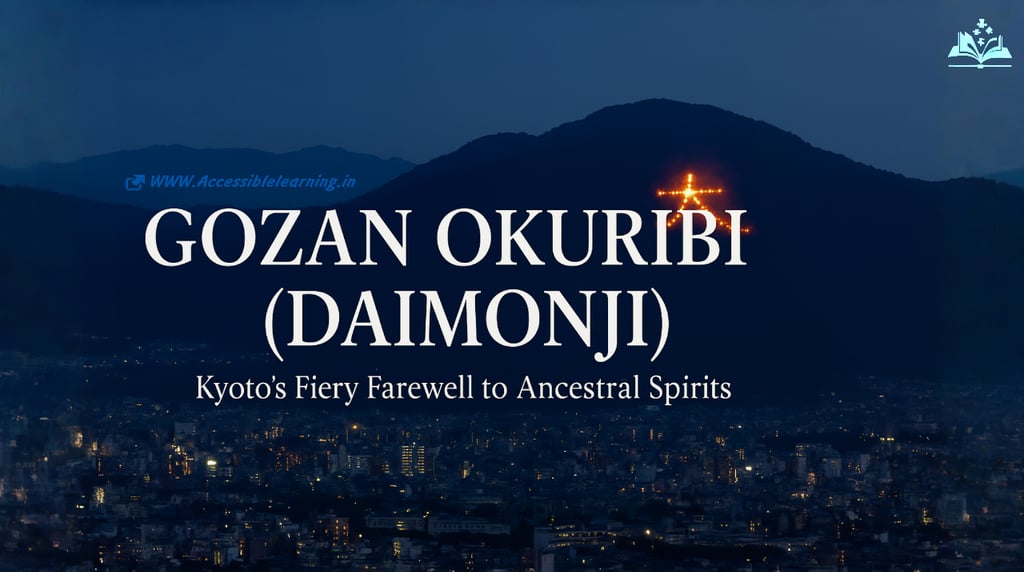
Gozan Okuribi (Daimonji): Kyoto’s Fiery Farewell to Ancestral Spirits
Discover Gozan Okuribi (Daimonji), Kyoto’s sacred fire festival that lights up five mountains to honor ancestral spirits. Explore its origins, meaning, best viewing tips, travel guide, and cultural significance in this complete guide.
CULTURE/TRADITIONEVENT/SPECIALJAPANCELEBRATION/FESTIVALS
Kim Shin
8/10/20253 min read


A Beacon of Spirit and Tradition
In the heart of Kyoto, when the sun sets on August 16th, five giant bonfires blaze atop the surrounding mountains. This striking spectacle, Gozan Okuribi (also known as Daimonji), isn’t just a visual marvel—it’s a spiritual ritual that marks the closing act of Obon, a Japanese Buddhist event to honor ancestral spirits.
Deeply rooted in centuries of tradition, this unique ceremony offers a moment of reflection, reverence, and visual beauty that captivates both locals and travelers from around the world.
What is Gozan Okuribi (Daimonji)?
Gozan Okuribi (五山送り火), literally meaning "Five Mountain Send-Off Fires," is a traditional Japanese fire festival held annually in Kyoto. It marks the end of Obon, a three-day period (typically August 13–16) when spirits of deceased ancestors are believed to return home. On the final day, the Okuribi fires guide the spirits back to the afterlife.
The most famous of these fires is the character "大" (Dai, or "Great") lit on Daimonji-yama mountain—hence the alternative name Daimonji Festival.
The Five Flaming Symbols: Their Shapes & Meanings
Each of the five fires appears as a large character or shape, visible from various parts of Kyoto. Here’s a breakdown:
大 (“Dai—"Great")—on ”Mount Daimonji (Higashiyama)
⏰ Lit at 8:00 PM
🗺️ Most iconic and best-known fire.妙・法 (“Myo・Ho—"Wonderful Dharma")—on ”Matsugasaki hills
⏰ Lit at 8:05 PM
📿 Together they represent Buddhist teachings.舟形 (Funagata—"Boat “Shape")—on ”Nishigamo Funa-yama
⏰ Lit at 8:10 PM
⛵ Symbolizes the spirits' boat returning to the spirit world.左大文字 (Hidari “Daimonji—"Left Great")—on ”Mount Okita
⏰ Lit at 8:15 PM
🔥 Similar to the first “大,” symbolizing strength and guidance.鳥居形 (“Toriigata—"Torii Gate")—on ”Mount Mandara
⏰ Lit at 8:20 PM
⛩️ Symbolizes entry to the spiritual world.
Each fire lasts for about 30 minutes, and their timed ignition follows a sequence that adds rhythm and reverence to the night.
Historical Origins: Ancient Flames of Faith
While the exact origins of Gozan Okuribi are debated, most historians trace the festival back to the early Edo period (1603–1868), though some believe its roots may stretch further into the Muromachi era (14th–16th centuries).
The ritual likely evolved from esoteric Buddhist practices, particularly related to mountain worship and fire as a purification element. Over time, it became part of Obon—Japan’s sacred time for honoring ancestors.
Cultural & Spiritual Significance
Beyond its breathtaking visuals, Gozan Okuribi serves a profound spiritual purpose:
Farewell Ritual: It sends the visiting ancestral spirits back to their realm with warmth and honor.
Purification & Protection: Fire symbolizes purification, warding off evil, and cleansing the space.
Community Bonding: Kyoto families often gather on rooftops or riverbanks, watching the flames while offering silent prayers.
In many homes, people light ceremonial lanterns and place them by rivers, guiding spirits gently back toward the mountains and spirit world.
Best Places to View Gozan Okuribi
Want to experience the fires in person? These are some of the top viewing spots in Kyoto:
Kamo River Banks (between Marutamachi and Demachiyanagi Bridges)—Panoramic views of multiple fires.
Funaokayama Park—Elevated spot near the "Funagata" fire.
Mount Yoshida—Great for the “Dai” Fire.
Shogunzuka Overlook—Offers distant but full visibility of all five fires (bring binoculars!).
💡 Pro Tip: Arrive early (by 6 PM) to secure a good spot, as this is one of Kyoto's busiest evenings.
Modern Challenges & Preservation
As with many ancient traditions, Gozan Okuribi faces challenges from modernization—ranging from environmental concerns to declining volunteers for fire-setting roles.
However, local community groups and temples continue to protect the legacy with passion. Strict rules on materials (only natural woods are used) and controlled ignitions ensure the event remains safe, sacred, and environmentally respectful.

Why You Should Witness Gozan Okuribi At Least Once!
Gozan Okuribi isn’t just a cultural curiosity—it’s a deeply moving display of Japan’s spiritual grace, blending nature, ritual, and visual poetry. In a world moving fast, these slow-burning characters in the night sky remind us to pause, remember, and revere.
Whether you're a spiritual seeker, cultural traveler, or photography enthusiast, Kyoto’s blazing hills in mid-August are an unforgettable encounter with living tradition.
FAQs
Q: When is Gozan Okuribi celebrated?
Every year on August 16th, from 8:00 PM onward.
Q: Is Gozan Okuribi religious?
Yes, it has strong Buddhist and Shinto roots, associated with Obon and ancestral worship.
Q: Is the festival open to tourists?
Absolutely. Visitors are welcome to watch, but it’s encouraged to remain respectful and silent during the event.
Q: What happens if it rains?
Unless there’s a safety threat (like a typhoon), the fires are lit rain or shine.
Q: Are there other events during Obon in Kyoto?
Yes—Kyoto hosts temple ceremonies, lantern festivals, and bon odori dances during Obon Week (August 13–16).
Subscribe To Our Newsletter
All © Copyright reserved by Accessible-Learning Hub
| Terms & Conditions
Knowledge is power. Learn with Us. 📚


